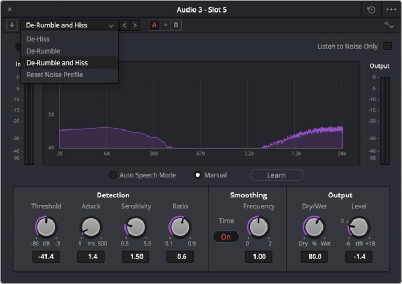
< Previous | Contents | Next >
— Master: Controls for adjusting the final output from this plugin.
— Gain (dB): Adjusts the overall output level of the affected sound by adding or reducing 18 dB of gain.
— Q: Adjusts the width of affected frequencies. Lower values include a wider range of frequencies, higher values include a narrower range of frequencies.
Noise Reduction
A repair plugin designed to reduce a wide variety of noise in all kinds of recordings. A graph shows a spectral analysis of the audio being targeted, along with a purple overlay that shows what noise is being targeted. Two audio meters let you evaluate the input level (to the left) versus the output level (to the right), to compare how much signal is being lost to noise reduction. There are three default presets: De-Hiss, De-Rumble, and De-Rumble and Hiss.

The Noise Reduction Fairlight FX in action
Noise Reduction has the following controls:
— Bypass: Toggles this plugin on and off.
— Listen to Noise Only: This checkbox at the top right lets you listen only to the noise that is being removed. This is very useful to determine if too much signal is being removed or if more noise attenuation can be applied.
![]()
— Threshold (in dB): Relates to the signal-to-noise ratio (SNR) in the source recording. Recordings with a poor signal-to-noise ratio will require a higher threshold value, resulting in more noise reduction being applied.
— Attack (in ms): Primarily useful in Auto Speech mode, this controls the duration over which the noise profile is detected. Ideally, the attack time should match the variability of the unwanted noise. A low value corresponds to a faster update rate of the noise profile and is useful for quickly varying noise; a high value corresponds to a slower update rate and can be used for noise that’s more consistent.
— Sensitivity: Higher sensitivity values exaggerate the detected noise profile; the result is that more noise will be removed, but more of the dialogue you want to keep may be affected.